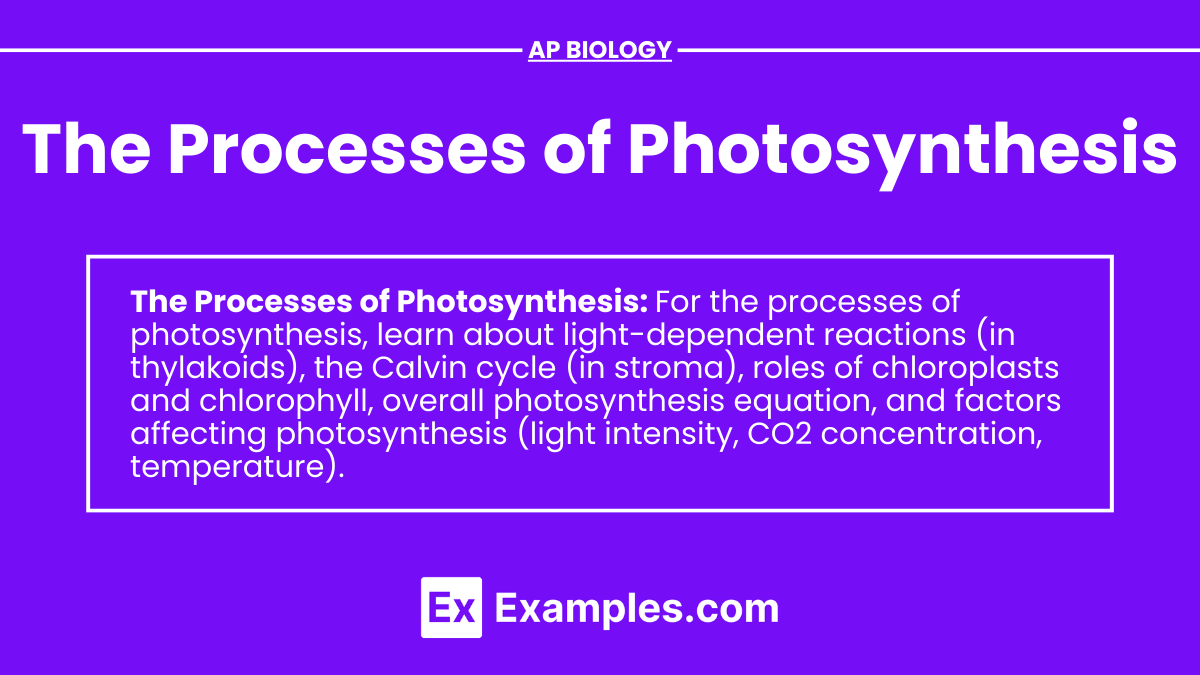In AP Biology, photosynthesis is a crucial topic that explains how plants convert light energy into chemical energy. This process involves unique chemical properties of chlorophyll and other pigments that capture light, enabling the transformation of carbon dioxide and water into glucose and oxygen. Understanding photosynthesis is essential for grasping how energy flows through ecosystems and how living organisms depend on this chemical energy for survival.
Learning Objectives
Learning objectives for AP Biology on photosynthesis include understanding the structure and function of the chloroplast and the role of chlorophyll in capturing light energy. Students should explain how plant cells convert light energy into chemical energy, and describe the steps of the carbon cycle that involve photosynthesis. Additionally, they should understand how photosynthesis impacts energy flow and nutrient cycling within ecosystem.
Overview of Photosynthesis
Equation:6CO₂+6H₂O+ light energy→C₆H₁₂O₆+6O₂
Location: Occurs in the chloroplasts of plant cells and algae.
Structure of the Chloroplast
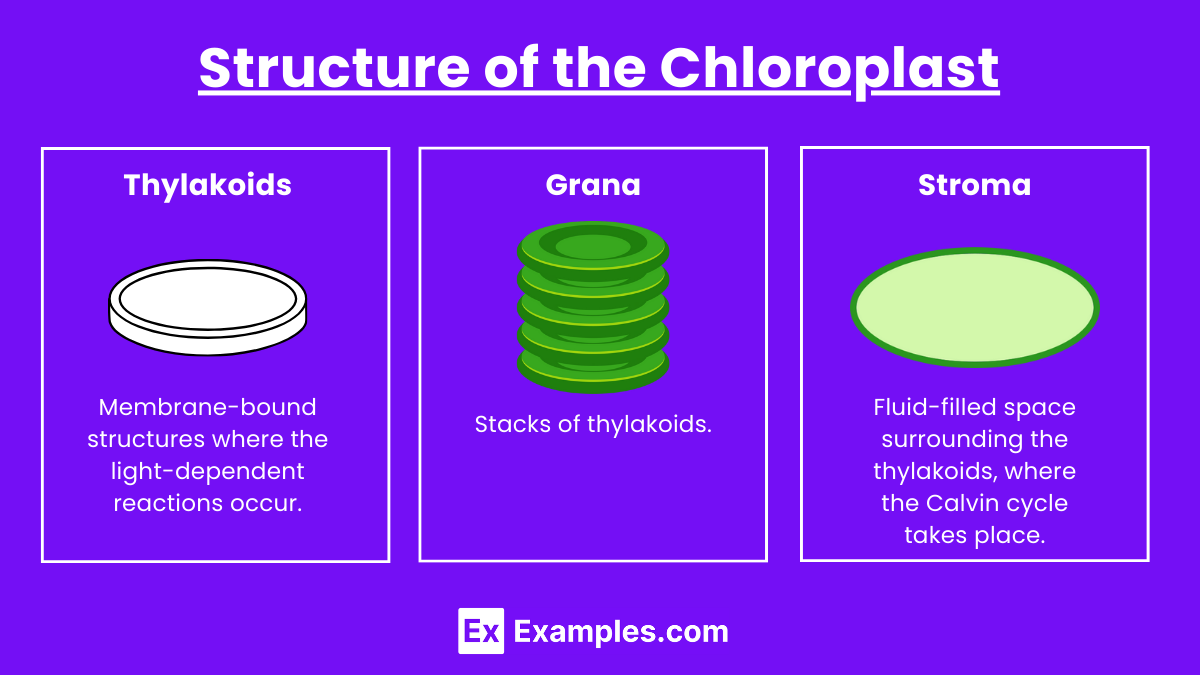
Thylakoids: Membrane-bound structures where the light-dependent reactions occur.
Grana: Stacks of thylakoids.
Stroma: Fluid-filled space surrounding the thylakoids, where the Calvin cycle takes place.
Stages of Photosynthesis
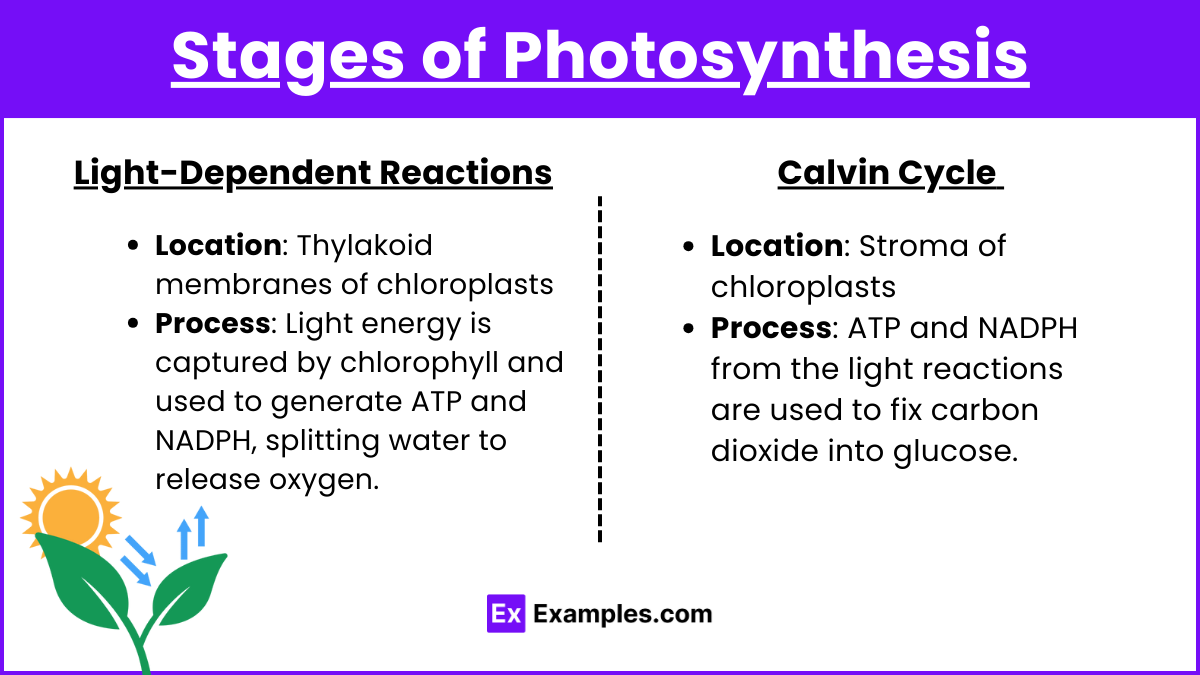
Light-Dependent Reactions
Location: Thylakoid membranes.
Function: Convert light energy into chemical energy (ATP and NADPH), releasing oxygen as a byproduct.
Key Components:
Photosystem II (PSII): Absorbs light, splitting water molecules to release oxygen, protons, and electrons.
Electron Transport Chain (ETC): Transfers electrons from PSII to Photosystem I (PSI), creating a proton gradient that drives ATP synthesis.
Photosystem I (PSI): Absorbs light, further energizing electrons to reduce NADP+ to NADPH.
Products: ATP, NADPH, O₂.
Calvin Cycle (Light-Independent Reactions)
Location: Stroma of the chloroplast.
Function: Uses ATP and NADPH from the light-dependent reactions to convert CO₂ into glucose.
Phases:
Carbon Fixation: CO₂ is attached to a five-carbon sugar (RuBP) by the enzyme rubisco, forming a six-carbon intermediate that splits into two three-carbon molecules (3-PGA).
Reduction: ATP and NADPH are used to convert 3-PGA into G3P (glyceraldehyde-3-phosphate), a three-carbon sugar.
Regeneration: Some G3P molecules exit the cycle to form glucose, while others are used to regenerate RuBP, allowing the cycle to continue.
Products: G3P (which can be used to form glucose and other carbohydrates).
Importance of Photosynthesis
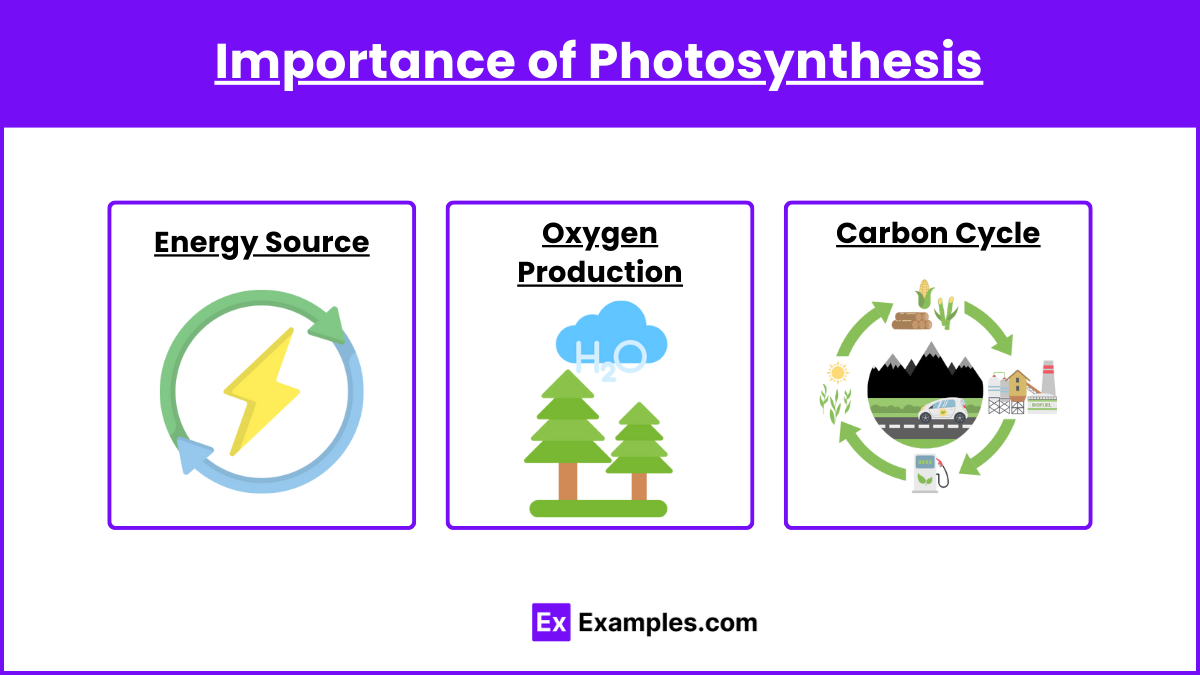
Energy Source
Photosynthesis provides the primary energy source for nearly all ecosystems. Glucose produced is used by plants for energy and growth and serves as food for other organisms.
Oxygen Production
Photosynthesis is the primary source of atmospheric oxygen, essential for aerobic respiration in most living organisms.
Carbon Cycle
Photosynthesis plays a critical role in the carbon cycle by converting CO₂ into organic molecules, reducing atmospheric CO₂ levels.
Factors Affecting Photosynthesis
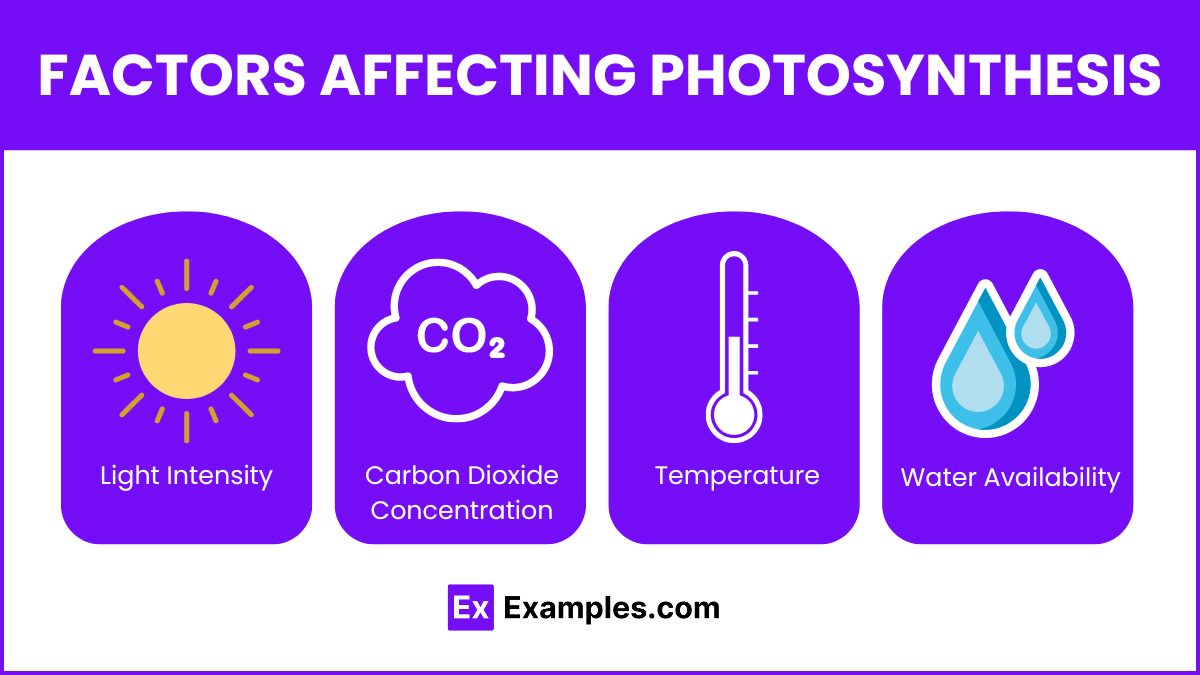
Light Intensity
Increased light intensity boosts the rate of photosynthesis up to a point, beyond which it plateaus.
Carbon Dioxide Concentration
Higher CO₂ levels can enhance photosynthesis rates until the process becomes saturated.
Temperature
Photosynthesis operates optimally within a certain temperature range. Extreme temperatures can denature enzymes involved in the process, reducing efficiency.
Water Availability
Water is a substrate in the light-dependent reactions. Limited water can slow or halt photosynthesis.
Adaptations in Photosynthesis
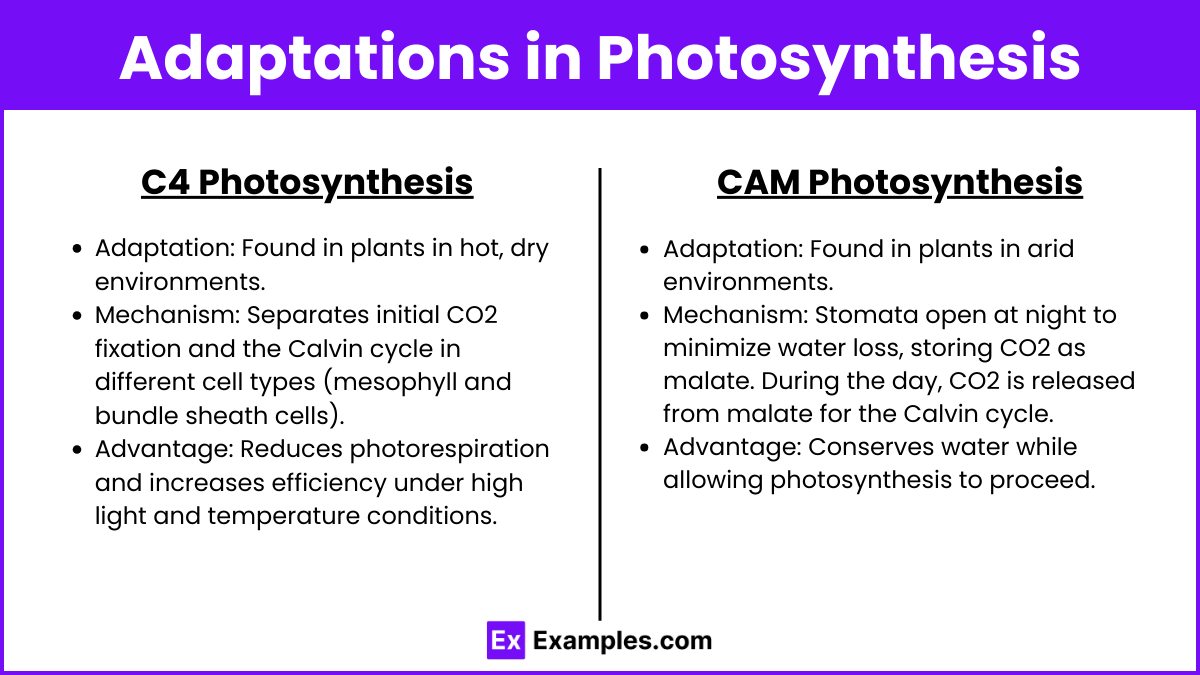
C₄ Photosynthesis
Adaptation: Found in plants in hot, dry environments.
Mechanism: Separates initial CO₂ fixation and the Calvin cycle in different cell types (mesophyll and bundle sheath cells).
Advantage: Reduces photorespiration and increases efficiency under high light and temperature conditions.
CAM Photosynthesis
Adaptation: Found in plants in arid environments.
Mechanism: Stomata open at night to minimize water loss, storing CO₂ as malate. During the day, CO₂ is released from malate for the Calvin cycle.
Advantage: Conserves water while allowing photosynthesis to proceed.
Experimentation and Observation
Leaf Disk Assay: Demonstrates oxygen production by leaf disks in a bicarbonate solution exposed to light, causing them to float.
Chromatography: Separates plant pigments (chlorophyll a, chlorophyll b, carotenoids) to study their roles in light absorption.

